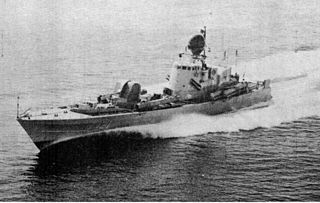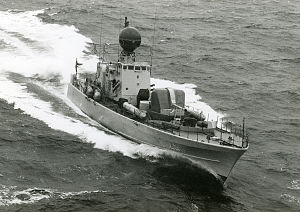
HSwMS Småland (J19) is a Swedish Halland-class destroyer. She and HSwMS Halland were the only ones built of their class. Two more ships were ordered but they were never completed.
The 1.-class torpedo boat was a designation in the Scandinavian countries for a type of fast steam ships on more than 80 tons.
Spica is the brightest star in the constellation Virgo.

The Stockholm class is a pair of warships of the Swedish Navy. Built as corvettes in Karlskrona 1984–1985, they are armed with four RBS15 anti-ship missiles, one 57 mm cannon and several machine guns. In 2017 the two units in the class were rebuilt and are now serving as patrol boats. The option to carry anti-ship missiles does however remain.

HSwMS Spica (T121) is a former Swedish Navy Spica-class, torpedo-armed, fast attack craft (FAC), now a museum ship at the Vasa Museum in Stockholm, Sweden.
Sweden played a role of major importance during the Cold War, despite not officially participating. Sweden's location made it an ideal base of operations for both the Soviet Union and the United States. Sweden was never invaded throughout the war, mainly due to their strong defensive power - ranked among the top five in the world at this time.

The Romulus class was a class of two destroyers operated by the Royal Swedish Navy during the Second World War. The class consisted of HSwMS Romulus and HSwMS Remus. They were built in Italy as the Spica-class torpedo boats Spica and Astore in the mid-1930s and sold to Sweden in 1940. The two ships were adapted for northern conditions and remained in service during World War II and into the first decades of the Cold War. They were modernized and re-designated as anti-submarine frigates in 1953. Both ships were discarded in 1958.

The Spica class was a class of six fast torpedo boats built for the Swedish Navy in the 1960s and decommissioned in the late 1980s. One ship, HSwMS Spica, is preserved as a museum ship in Stockholm, Sweden.

The Norrköping class were a group of fast attack craft built for the Swedish Navy in the 1970s. Twelve ships were built, with the last ship decommissioned in 2005. The boats have also been called the Spica II class and were named after Swedish cities.
Several ships of the Swedish Navy have been named HSwMS Spica, named after the Spica star:
Several ships of the Swedish Navy have been named HSwMS Tordön or HSwMS Thordön, named after the Old Norse word for thunder:
Spica has been borne by at least four ships of the Italian Navy and may refer to:

HSwMS Sirius (T122) was a Swedish Navy Spica-class, torpedo-armed, fast attack craft (FAC).

HSwMS Castor (T124) was a Swedish Navy Spica-class, torpedo-armed, fast attack craft (FAC).

HSwMS Vega (T125) was a Swedish Navy Spica-class, torpedo-armed, fast attack craft (FAC).

HSwMS Virgo (T126) was a Swedish Navy Spica-class, torpedo-armed, fast attack craft (FAC).

HSwMS Halland (J18) was the lead ship of the Halland-class destroyer. She and HSwMS Småland were the only ones built of their class. Two more ships were ordered but they were never completed.










